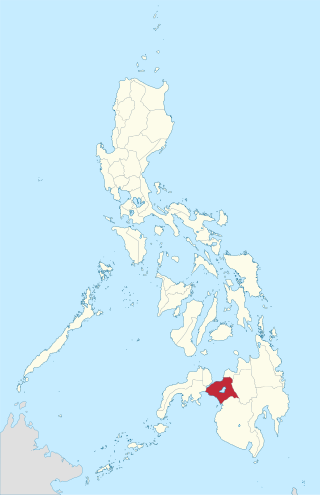
Zamboanga was a province of the Philippines located in the western region of the southern island of Mindanao, Philippines.

In the Philippines, provinces are one of its primary political and administrative divisions. There are 82 provinces at present, which are further subdivided into component cities and municipalities. The local government units in the National Capital Region, as well as independent cities, are independent of any provincial government. Each province is governed by an elected legislature called the Sangguniang Panlalawigan and an elected governor.

The Autonomous Region in Muslim Mindanao was an autonomous region of the Philippines, located in the Mindanao island group of the Philippines, that consisted of five predominantly Muslim provinces: Basilan, Lanao del Sur, Maguindanao, Sulu, and Tawi-Tawi. It was the only region that had its own government. The region's de facto seat of government was Cotabato City, although this self-governing city was outside its jurisdiction.

Moro Province was a province of the Philippines consisting of the regions of Zamboanga, Lanao, Cotabato, Davao, and Jolo. It was later split into provinces and regions organized under the Department of Mindanao and Sulu, along with the former provinces of Agusan, and current province of Bukidnon.
The legislative district of Agusan was the representation of the historical province of Agusan in the various national legislatures of the Philippines until 1969. Butuan also remained part of the province's representation even after becoming a chartered city in 1950.
The legislative district of Zamboanga was the representation of the historical province of Zamboanga in the various national legislatures of the Philippines until 1953. The undivided province's representation encompassed the present-day provinces of Basilan, Zamboanga del Norte, Zamboanga del Sur and Zamboanga Sibugay, and the highly urbanized city of Zamboanga.
The Interim Batasang Pambansa was the legislature of the Republic of the Philippines from its inauguration on June 12, 1978, to June 5, 1984. It served as a transitional legislative body mandated by the 1973 Constitution as the Philippines shifted from a presidential to a semi-presidential form of government.

The legislative districts of Bukidnon are the representations of the province of Bukidnon in the various national legislatures of the Philippines. The province is currently represented in the lower house of the Congress of the Philippines through its first, second, third, and fourth congressional districts.
The legislative districts of Sulu are the representations of the province of Sulu in the various national legislatures of the Philippines. The province is currently represented in the lower house of the Congress of the Philippines through its first and second congressional districts.
The legislative district of Davao was the representation of the historical province of Davao in the various national legislatures of the Philippines until its dissolution in 1967.
The legislative districts of Cotabato are the representations of the province of Cotabato in the various national legislatures of the Philippines. The province is currently represented in the lower house of the Congress of the Philippines through its first, second, and third congressional districts.

The legislative districts of Sultan Kudarat are the representations of the province of Sultan Kudarat in the various national legislatures of the Philippines. The province is currently represented in the lower house of the Congress of the Philippines through its first and second congressional districts.
The legislative district of Lanao was the representation of the historical province of Lanao in the various national legislatures of the Philippines until 1969. Marawi and Iligan also remained part of the province's representation even after becoming chartered cities in 1940 and 1950, respectively.

The Department of Mindanao and Sulu was an agency of the United States colonial administration in the Philippine Islands task to administer all Muslim-dominated areas in the territory. It was established on July 23, 1914, pursuant to Act No. 2408, replacing the Moro Province after the latter was divided into the then districts/provinces of Zamboanga, Lanao, Cotabato, Davao, and Sulu. It was later split into provinces/regions organized under the Department of Mindanao and Sulu, along with the former provinces of Agusan, and current province of Bukidnon.

The Christian And Missionary Alliance Churches of the Philippines (CAMACOP) is a Christian evangelical group in the Philippines that originated from The Christian and Missionary Alliance (C&MA). It is one of the largest evangelical groups in the Philippines.

Lanao was a province of the Philippines from 1914 to 1959. Today, the province comprises Lanao del Norte and Lanao del Sur.

Cotabato, also known as the Province of Cotabato, was a historical province of the Philippines established in 1914 that existed until its dissolution in 1973. The province's capital from 1920 to 1967 was Cotabato City while Pagalungan became its capital from 1967 to 1973.

Agusan was a province of the Philippines. It existed from 1907 to 1967, when it was divided into the present-day provinces of Agusan del Norte and Agusan del Sur.
Philippines's 12th senatorial district, officially the Twelfth Senatorial District of the Philippine Islands, was one of the twelve senatorial districts of the Philippines in existence between 1916 and 1935. Unlike the first eleven districts which elected two members each to the Senate of the Philippines, the upper chamber of the bicameral Philippine Legislature under the Insular Government of the Philippine Islands, the two senators from this district were appointed by the Governor-General of the Philippines to serve indefinite terms in the 4th to 10th legislatures. The district was created under the 1916 Jones Law to represent the non-Christian tribes of the northern Luzon provinces of Mountain Province and Nueva Vizcaya, the city of Baguio, and the Moro people and other non-Christian tribes of the Department of Mindanao and Sulu provinces of Agusan, Bukidnon, Cotabato, Davao, Lanao, Sulu and Zamboanga.
Bukidnon's at-large congressional district refers to the lone congressional district of the Philippines in the province of Bukidnon. It existed between 1935 and 1986 as either a single or plural member constituency for several national legislatures.












